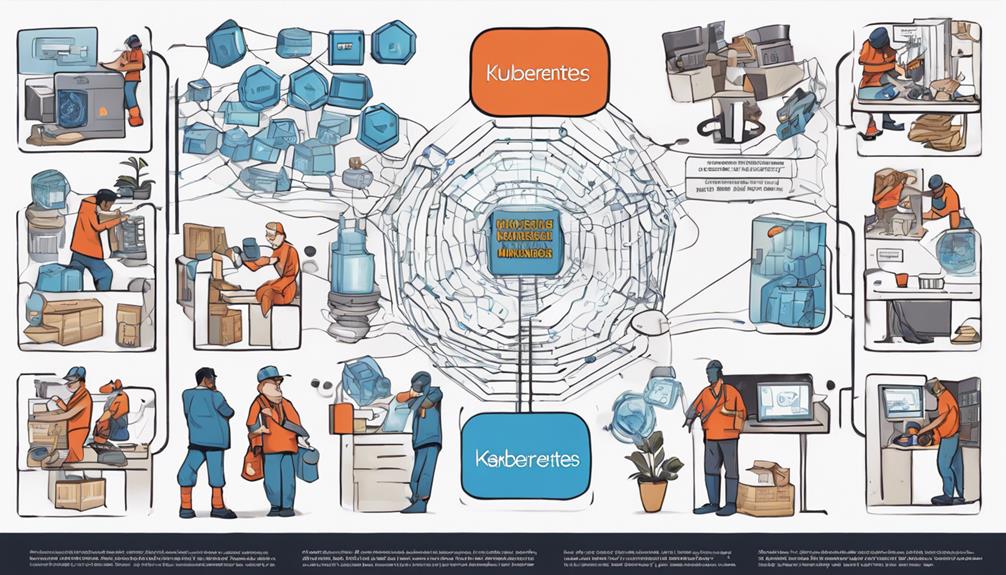Using base64 encoding for secret storage in Kubernetes isn’t secure, as it’s easily reversible and offers no encryption. To truly protect sensitive data, enable secrets encryption at rest within the API server, and restrict access with proper RBAC controls. Consider integrating external tools like HashiCorp Vault or AWS Secrets Manager for enhanced security and audit capabilities. Implementing these best practices helps you avoid common pitfalls and keep your secrets safe—learn more about strengthening your secret management strategy.
Key Takeaways
- Avoid storing secrets in plain base64; instead, enable encryption at rest to protect sensitive data.
- Configure Kubernetes API server with encryption providers like AES to secure secrets before writing to disk.
- Implement strict RBAC policies to restrict secret access and prevent unauthorized retrieval.
- Use external secret management tools such as HashiCorp Vault for centralized, encrypted secret storage.
- Never expose secrets via environment variables or logs; prefer volume mounts or secret APIs for safer access.

Have you ever wondered how to securely store sensitive information like passwords, API keys, and tokens in a Kubernetes environment? The key to keeping these secrets safe lies in understanding how secrets encryption and access controls work together. Kubernetes offers built-in mechanisms for secret management, but if you overlook encryption and proper access controls, you risk exposing your sensitive data. By default, secrets are stored in base64 encoding, which isn’t encryption—it’s merely encoding that’s easily reversible. Relying solely on this means anyone with access to the etcd database, where secrets are stored, can decode and access your sensitive information. To prevent this, you need to enable secrets encryption at rest, ensuring secrets are encrypted before being written to disk. This adds a crucial security layer, making it substantially harder for attackers to decipher stored secrets even if they gain access to the database. Implementing secrets encryption involves configuring the Kubernetes API server with an encryption provider, typically using AES-CBC or a similar encryption mechanism. Once enabled, secrets remain encrypted at rest, reducing the risk of data leaks if someone gains unauthorized access to your storage. Additionally, understanding the storage backend used by Kubernetes can help you identify potential vulnerabilities and optimize your secret management strategy. Equally important is setting strict access controls around secrets. Kubernetes offers Role-Based Access Control (RBAC), which allows you to specify exactly who can read, modify, or delete secrets. You shouldn’t give every user or service account permission to access all secrets; instead, tailor access based on roles and responsibilities. This minimizes the attack surface and ensures that only authorized entities can retrieve sensitive information. Combining secrets encryption with rigorous access controls creates a layered defense—encryption protects secrets stored at rest, while access controls limit who can view or manipulate them. Regularly auditing these permissions helps you detect any unintended access and tighten security. Additionally, consider integrating external secret management tools, such as HashiCorp Vault or AWS Secrets Manager, which offer advanced encryption capabilities and centralized control. These tools can sync secrets with Kubernetes, providing an extra safeguard and audit trail. Remember, even with encryption and access controls in place, you should avoid exposing secrets unnecessarily in environment variables or logs. Instead, use volume mounts or dedicated secret management APIs to inject secrets into your applications securely.
Frequently Asked Questions
How Do I Rotate Secrets Securely in Kubernetes?
To rotate secrets securely in Kubernetes, you should implement secret versioning to track changes and guarantee smooth rollouts. Use access control to restrict who can modify secrets, reducing risks. Regularly update secrets, then deploy these updates carefully with minimal downtime. Automate the rotation process when possible, and verify that applications refresh their secrets promptly, maintaining security and consistency across your environment.
What Are the Best Practices for Storing Sensitive Data?
When storing sensitive data, you should use strong encryption strategies to protect your secrets at rest and in transit. Implement strict access controls to limit who can view or modify this data, ensuring only authorized personnel or services have access. Avoid relying solely on base64 encoding, as it’s not encryption. Instead, leverage Kubernetes secrets with encryption at rest and role-based access controls to keep your data secure and protected from unauthorized access.
Can Secrets Be Accessed by Unauthorized Users?
Think of your secrets as delicate treasures hidden behind fortress walls. Unauthorized users can access them if you don’t set proper access control and monitor activity through audit logging. Without these defenses, your secrets become open books to intruders. So, always enforce strict access policies and keep detailed logs. This way, you can catch any sneaky attempts and keep your sensitive information safe from prying eyes.
How Does Kubernetes Integrate With External Secret Management Tools?
You can enhance secret storage in Kubernetes by integrating with external secret management tools. Kubernetes supports external integration through solutions like HashiCorp Vault, AWS Secrets Manager, and Azure Key Vault, allowing you to securely fetch secrets at runtime. This setup helps you avoid storing sensitive data directly in Kubernetes, ensuring better security and control over secret access, while maintaining seamless access for your applications.
What Are the Risks of Using Base64 Encoding for Secrets?
Think of base64 encoding as a magician’s illusion—it’s not real security. Relying on it for secrets is a dangerous misconception. It might hide data temporarily, but it doesn’t encrypt or protect against secret exposure. If someone gains access, they can easily decode base64, exposing sensitive information. Avoid this illusion by using proper secret management tools, because relying solely on base64 leaves your secrets vulnerable to unwelcome surprises.
Conclusion
To secure your Kubernetes secrets, avoid the pitfalls of base64 encoding, avoid plain text, and avoid insecure storage. Instead, encrypt your secrets, audit your access, and automate your management. By doing so, you protect your data, strengthen your security, and build your confidence. Remember, securing secrets isn’t a one-time task; it’s a continuous process. Stay vigilant, stay proactive, and keep your Kubernetes environment safe and resilient.









